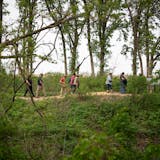Minnesota farmers will be given extra time and in some cases financial help to comply with the state's buffer law that requires them to plant perennial vegetation between crops and creeks.
The changes were included in bills signed Tuesday by Gov. Mark Dayton.
But farm groups say the changes don't go far enough, and environmental leaders object to how the measure would be funded.
The law, passed in 2015, seeks to improve water quality by requiring buffer strips along ditches and waterways to help slow down and filter runoff from farm fields that might contain sediment, phosphorus, pesticides and other chemicals.
It was set to go into effect Nov. 1, and requires strips at least 30 feet wide and an average of 50 feet from public streams, creeks, rivers and lakes, or an alternative method of conservation that provides equal or better water quality benefits. It also applies to public ditches that feed into waterways, and requires 16.5-foot buffers along them to be planted by Nov. 1, 2018.
Farmers and farm groups complained that the deadlines were unrealistic, but Dayton considers the law one of his signature accomplishments and pushed back against attempts to delay or weaken it.
In the end, lawmakers and the governor's office agreed on a plan that allows farmers to apply for an automatic waiver that gives them until July 1, 2018, to install buffers or alternative measures along the public waterways. The deadline for ditches was not changed.
The extension is more of a grace period than a delay, said John Jaschke, executive director of the Minnesota Board of Water and Soil Resources, which is responsible for administering the law. Some farmers may face weather conditions, crop harvests or other circumstances that may make it difficult to install buffers by this year's Nov. 1 deadline, he said, so they can explain their reasons and apply for a waiver.
![Three weeks ago, Octavio Rodriguez switched from making transmission parts to casting parts for hospital bed brake assemblies at Twin City Die Castings. ] GLEN STUBBE • glen.stubbe@startribune.com Thursday, April 9, 2020 How employee-owned Twin City Die Casting, which just laid off 40 production workers of its 250 employees in what was supposed to be a good year, is trying to accelerate its pivot to growing medical parts business for ventilators, hospital beds, etc as it copes with instan](https://arc.stimg.co/startribunemedia/WNZYKGTZ5IYMUCO3KI5TR3N7WI.jpg?&w=80&ar=1:1&fit=crop)

djoles@startribune.com As boaters flock to Minnesota lakes and rivers this holiday weekend for the unofficial kick-off to the boating season, they'll face more inspections in and out of the water as local cities and counties ramp up their work to stop the spread of invasive species. Across the metro, more boat accesses will be staffed by watercraft inspectors thanks to $10 million funneled to county government programs this year, up from $4.5 million the state allocated last year. ORG XMIT: MIN1505222156290209 ORG XMIT: MIN1506021218440580](https://arc.stimg.co/startribunemedia/34QSKO44B2XKVNUZCO5SLJQSLY.jpg?&w=80&ar=1:1&fit=crop)
